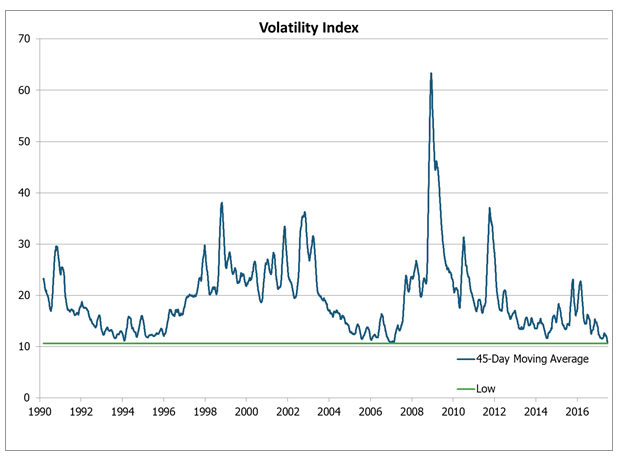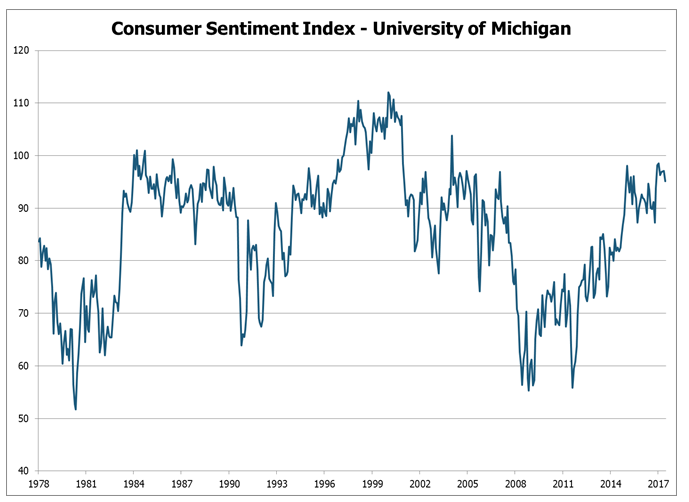Market Insight - August 2017
Investing is and has always been a balancing act of contradictions. President Harry Truman complained that he wanted someone to “give me a one-handed economist. All my economists say, ‘on the one hand…on the other’”. In today’s environment, we have elevated asset values in nearly all types of assets on one hand. But on the other hand, we have loose global monetary policy. Likewise, we have historically low levels of asset price volatility on one hand. But on the other hand, we have a geopolitical landscape that is disruptive and uncertain. So what can we do to weigh these factors and arrive at a decision on how to invest our assets?
Overcoming our Reservations
We likely face this weighing of factors in many facets of our lives when faced with a decision that needs to be made. Whether we identify it as such or not, we are really weighing pros and cons, or risks with expected results. Recently we took our family to the self-proclaimed Waterpark Capital of the World, Wisconsin Dells. My two sons are nine and six years old, so a pretty great age to embark on a family getaway like the Dells. When my nine-year-old, Liam, saw the Cosmic Drop water slide I could see that an inner conflict befell him immediately. He’s rarely intimidated by the potential for a thrill, but the idea of having a trap-door send him plummeting from five stories up was certainly giving him pause. I could see him weighing the pros and cons. Well, on the one hand it might be really fun and he could tell all his friends about it when we returned from vacation. But on the other hand, it looks scary as hell! I told him I’d do it with him in the hopes that he’d overcome his reservations, even though I was going through the same inner battle. He agreed and we began the climb amid screams from other thrill-seekers likely facing the same inner conflict we were as they plunged at 30-plus miles per hour down the water slide.
The Decision-Making Process
How we make decisions is different depending on the risks associated with the outcome of our decisions. Whether to go out to eat or make dinner at home is likely analyzed and a decision is made with relative ease compared to deciding to purchase a new car. Risks are outsized with the car purchase since we’re deciding whether to spend tens of thousands of dollars versus less than fifty going out to eat. Still, the car purchase decision isn’t overly complicated. We can work through that decision by weighing factors that are largely known, such as the monthly payments versus our monthly income, etc. So we first determine if we can afford it and then determine if we want it enough to justify the additional expense.
Making decisions on how to invest our money is a considerably more consequential matter and yet many don’t take the time or have the desire to properly evaluate investment choices. It is a nebulous undertaking. So many investors rely heavily on the recent performance of investments or the collective understanding of whether the market is booming or about to bust in order to decide where to invest their money. Even knowing this, it doesn’t change behavior.
It is exceptionally difficult to invest in a way that is contrary to popular conjecture or to invest in an asset that hasn’t performed well recently. And yet we all know the mantra of “buy low and sell high”.
The Status of our Current Market
It’s not surprising that volatility of asset prices has become synonymous with risk for many investors. We can check the value of our portfolios at the touch of a screen on our phones and see the daily fluctuations. That is the most frequent and readily accessible method we have for understanding the risk of our investments. Yet by this standard, the current stock market is carrying the lowest level of risk we’ve seen in the history of the CBOE Volatility Index (“VIX”).
Chart 1


Don't Get Caught up in the Details
Anecdotally, it doesn’t seem accurate that the stock market should be perceived as being lower risk today than it was at any point in the past 25-plus years. The S&P 500© Index is up nearly 18 percent over the past year and over 250 percent since the depths of the financial crisis in 20091. Still, a popular measure of the confidence of U.S. consumers, the University of Michigan: Consumer Sentiment© Index, has been posting very high levels of confidence in recent months. These high readings provide further evidence that the general public sees blue skies ahead. Taken together with the exceptionally low levels of market volatility, it would seem that we are in a fertile market environment.
Chart 2


We’re back to the question of how to distill the information available to us and make a decision on how to invest our money. Absent of a disciplined investment strategy it can be easy to become overwhelmed with this decision-making process. Too many details causing indecision, too many scars from previous poor experiences tainting our outlook, or even too much confidence in one’s abilities can lead to bad decisions. It may be difficult to remove yourself from the noise and focus on longer-term trends. What a disciplined strategy reminds us of is that the daily fluctuations of asset prices are not consequential and are not an appropriate measure of risk for long-term investors. Additionally, consumer sentiment is notoriously a poor indication of future stock market returns.
We believe it is best to design and implement an investment strategy that is focused on avoiding the noise associated with day-to-day market gyrations and instead set a course for achieving long-term objectives, such as providing us with the freedom to make other life choices that contribute to our enjoyment of living.
I’m not sure that everyone would agree that the Cosmic Drop water slide is contributive to the enjoyment of living. For my son Liam, the fear overcame him shortly after watching me flush down the chute. He descended the stairs as I watched from the bottom. I give him so much credit for even attempting it – there’s no way I would have without significant peer pressure at his age. His decision to go or not go on the ride was difficult for him as fear is a powerful emotion in all of us. Choosing how to invest your money without a strategy can leave us susceptible to similar emotional influences. While fear doesn’t seem to be the emotion coursing through stock market investors presently, the opposite emotion can be just as detrimental to investment decisions.
Table 1


We hope you enjoy reading these letters each quarter. There is a lot of information pushed at all of us constantly and our intent is that these letters can be grounding in a way that reinforces what we believe is a prudent long-term investment philosophy. We welcome your feedback on these letters or if you have questions that you’d like us to address in an upcoming letter, please send the feedback or questions directly to me at steve@birchwoodfp.com. Please also share any of these letters with others that you believe may benefit from the content.
1Source: Yahoo! Finance, Morningstar. S&P 500© Index returns referenced from July 1, 2016 to June 30, 2017 and from March 9, 2009 to June 30, 2017.
Chart 1
Source: Chicago Board Options Exchange, CBOE Volatility Index: VIX©, retrieved from FRED, Federal Reserve Bank of St. Louis. Data represents a 45-day moving average of closing values of the CBOE Volatility Index as well as the lowest 45-day moving average reading since the Index began in January, 1990 through June 30, 2017.
Chart 2
Source: University of Michigan, University of Michigan: Consumer Sentiment©, retrieved from FRED, Federal Reserve Bank of St. Louis.
Table 1
Source: Morningstar. Market indexes are unmanaged and investors cannot invest directly in indexes. However, these indexes are accurate reflections of the performance of the individual asset classes shown. All returns reflect past performance and should not be considered indicative of future results.




